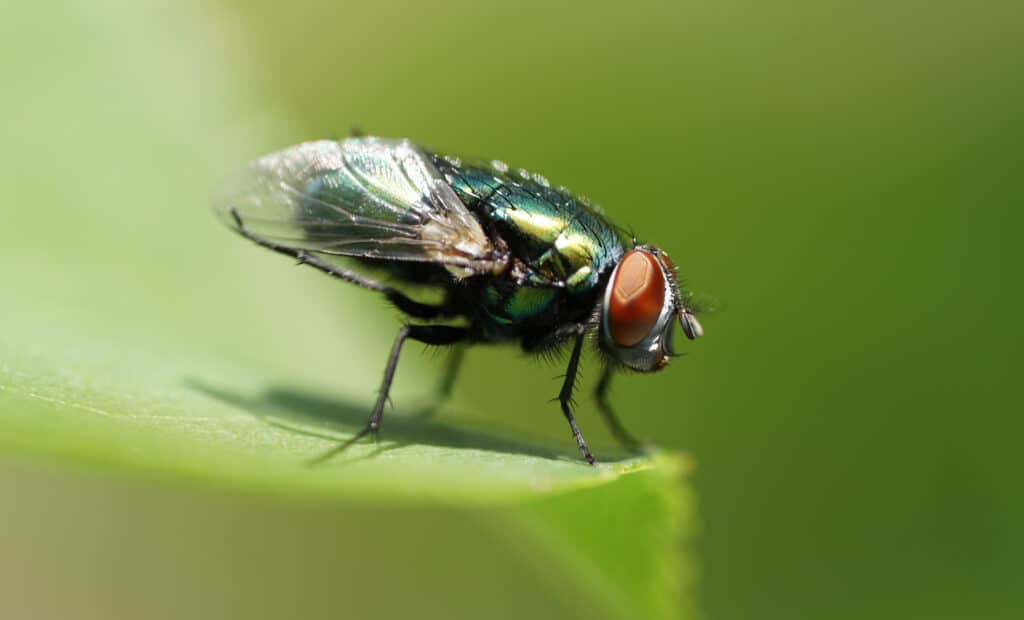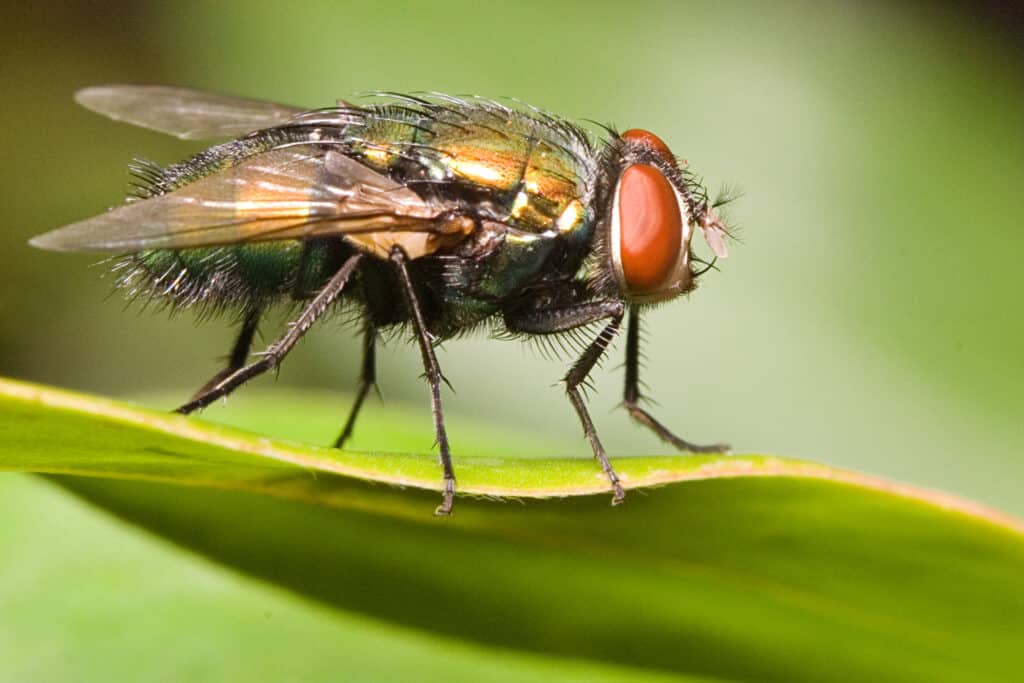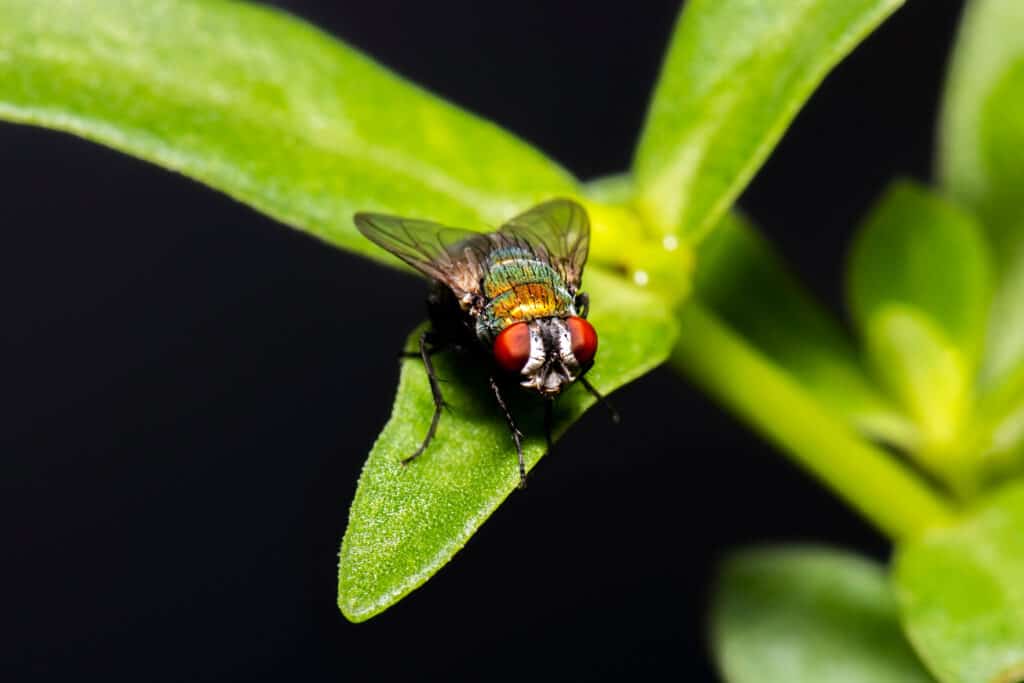Blowfly
Can smell rotting carcasses up to one mile away
Advertisement
Blowfly Scientific Classification
Read our Complete Guide to Classification of Animals.
Blowfly Conservation Status
Blowfly Facts
- Name Of Young
- Larvae (maggot)
- Group Behavior
- Solitary
- Fun Fact
- Can smell rotting carcasses up to one mile away
- Estimated Population Size
- Hundreds of billions
- Biggest Threat
- Insecticides and predators
- Most Distinctive Feature
- Colorful, metallic bodies
- Distinctive Feature
- Large compound eyes
- Other Name(s)
- Carrion flies, greenbottles, bluebottles
- Incubation Period
- Up to 48 hours
- Habitat
- Warm, humid enviornments
- Predators
- Frogs, spiders, beetles, birds
- Diet
- Omnivore
- Lifestyle
- Diurnal
- Favorite Food
- Carrion and dung
- Number Of Species
- 1900
- Location
- Worldwide
- Nesting Location
- Rotting animal flesh or dung
Blowfly Physical Characteristics
View all of the Blowfly images!
Blowflies go by many names, including carrion flies, bluebottles, or greenbottles. All 1,900 known species of blowfly belong to the family Calliphoridae. Most blowflies possess a shiny metallic blue or green coloring and characteristic hairlike bristles. In the environment, blowflies serve an important role as pollinators and recyclers of dead organic material. That said, they also transmit disease and cause millions of dollars in damage to various industries every year.
5 Blowfly Facts
- On average, adult blowflies live anywhere from two weeks to one month.
- The name blowfly comes from the old English term “flyblown,” or meat covered in fly eggs.
- Maggot debridement therapy uses laboratory-raised maggots to clean wounds that won’t heal conventionally, such as certain ulcers and post-surgical wounds.
- A blowfly can smell dead animals and other carrion up to one mile away.
- Forensic investors sometimes use blowflies in forensic science to estimate the time elapsed since death when examining a dead body.

All 1,900 described blowfly species are members of the family Calliphoridae.
©Moni.ka/Shutterstock.com
Blowfly Species, Types, and Scientific Name
Blowflies belong to the fly order Diptera, which includes over 125,000 known species and an estimated 1,000,000 species. In addition to blowflies, Diptera also contains well-known species such as horseflies, hoverflies, and craneflies.
All 1,900 described blowfly species are members of the family Calliphoridae. The family name translates roughly to “descended from the bearer of beauty.” It derives from the Latin word Cali, meaning “fairest” or “beautiful,” the Greek word phoros, meaning “bearer,” and the Latin suffix idae, meaning “descended from.” The family shares its name with the subfamily Calliphorinae and the genus Calliphora, the type genus of the family. French entomologist and physician Andre Jean Baptist Robineau-Desvoidy formally named the blowfly in 1830. While the reason for this name remains unknown, it likely has to do with the blowfly’s vibrant metallic blue and green coloration.
The blowfly’s common name stems from the old English term “flyblown.” At the time, people used the term to refer to meat covered in flies’ eggs. Some sources also contend the “blow” part of “blowfly” stems from the appearance of rotting animal carcasses. When carcasses become infected with maggots, they develop a bloated (blown) look. The term “blow” has been in use for over 500 years, with the earliest mentions stemming from several of William Shakespeare’s plays, including The Tempest, Antony and Cleopatra, and Love’s Labour’s Lost.
The blowfly family includes six major subfamilies: Bengaliinae, Calliphorinae, Chrysomyinae, Helicoboscinae, Luciliinae, and Melanomyinae. Too many genera and species exist to list them all here. That said, here are a few of the most well-studied blowfly genera:
- Abago
- Amenia
- Cynomya
- Bengalia
- Booponus
- Calliphora
- Chrysomya
- Cochliomya
- Cochliomyia
- Compsomyiops
- Cordylobia
- Cyanus
- Eumesembrinella
- Lucilia
- Melinda
- Nesodexia
- Phormia
- Protocalliphora
- Protophormia
- Trypocalliphora

Blowflies vary wildly in color, but most feature a metallic blue or green thorax and abdomen.
©Martin Pot1579531252/Shutterstock.com
Appearance: How to Identify Blowflies
In terms of size, adult blowflies measure between 0.125-0.625 inches long. That said, most adult blowflies range from 0.3-0.4 inches long. Blowflies vary wildly in color, but most feature a metallic blue or green thorax and abdomen. Other standard colors include black and bronze.
Blowflies possess antennae with three segments and an aristate, a bristle connected to the third segment. The second segment of the antennae has distinctive grooves. The abdomen usually measures slightly smaller than the thorax. All blowflies sport hairlike bristles on the legs, thorax, and abdomen. Experts use these bristles’ size, arrangement, color, and shape to distinguish between different species. Like all true flies, blowflies possess one pair of wings, large compound eyes, and spongelike mouthparts.
Meanwhile, blowfly maggots appear like small, white, or yellow worms. Maggots vary in size from 0.35-0.86 inches long. They are equipped with hooklike mouthparts, and each body segment features hairlike, fleshy tubercles.
Habitat: Where to Find Blowflies
Blowflies enjoy a cosmopolitan distribution and can be found in almost every country on Earth. Although you can find blowflies worldwide, the greatest species diversity exists in Latin and South America, Africa, and Southern Europe. Although they can survive in various habitats, blowflies are typically found in tropical and subtropical areas. They prefer areas with damp, loose soil where larvae can thrive. While some species prefer cooler temperatures and shade, others do better in hot, humid temperatures. Additionally, seasonal variation also exists, with some species becoming more active in summer while others are more often found in winter.
You can often find blowflies in and around dead animals or other dead organic materials. Common locations where blowflies congregate include garbage dumps, meat processing plants, restaurants, and farms. You can also often find them around trash cans or inside homes. When found inside a house, this usually indicates the presence of dead or diseased pests such as rats or mice.
Diet: What Do Blowflies Eat?
Blowflies are attracted to strong odors. An adult blowfly can detect rotting meat up to one mile away. Due to their attraction to strong smells, they often act as pollinators for strong-smelling flowers. They rely on the carbohydrates collected from the nectar of these plants to fuel their flight.
Blowflies feed on various decaying and dead organic substances, including garbage and rotting vegetation. Blowflies gather most of their calories from animal carcasses and feces, depending on the species. Female blowflies lay their eggs inside the carcasses of dead animals or dung, as their maggots require such environments to grow and develop.

The best way to prevent blowflies is to dispose of animal carcasses and feces properly.
©Rob D the Baker/Shutterstock.com
Prevention: How to Get Rid of Blowflies
You can prevent and get rid of blowflies in a variety of ways. The most popular methods include chemical and cultural controls. The best results usually occur when you employ numerous methods simultaneously.
The best way to prevent blowflies is to dispose of animal carcasses and feces properly. Animal carcasses should be buried at least 12 inches under the ground or placed in a sealed trash bag. To keep blowflies away from trash cans, close trash cans when not in use and clean cans regularly. You can also use blowfly traps — such as sticky or ultraviolet light traps — to reduce blowfly numbers.
Numerous chemical products exist that ward off blowflies. You can spray these insecticides around your home or business. Most commercial insecticides contain components that attract the flies and poisons that kill the flies once ingested.
Related Animals
View all 285 animals that start with BBlowfly FAQs (Frequently Asked Questions)
What animals prey on blowflies?
Numerous animals prey on blowflies, including spiders, frogs, beetles, and birds.
How many eggs do female blowflies lay?
A single female blowfly can lay anywhere from 150-500 eggs at a time, although 200-300 eggs are more common.
Are blowflies dangerous?
Unlike horseflies, blowflies do not bite humans. However, certain species can transmit dangerous conditions. Blowfly maggots can infest living animals and cause a parasitic condition known as myiasis. Adult blowflies can also transmit diseases such as dysentery.
How long do blowflies live?
On average, the blowfly life cycle takes 3-4 weeks to complete. Blowfly eggs can hatch within just eight hours or a few days. Upon hatching, maggots take 4-10 days to mature into the adult stage. Finally, adult blowflies can live anywhere from two weeks to a month.
Thank you for reading! Have some feedback for us? Contact the AZ Animals editorial team.
Sources
- , Available here: https://livestockvetento.tamu.edu/insectspests/blow-fly-calliphoridae/
- , Available here: https://agrilifeextension.tamu.edu/asset-external/controlling-blow-flies/
- , Available here: https://hortnews.extension.iastate.edu/blow-and-flesh-flies

















